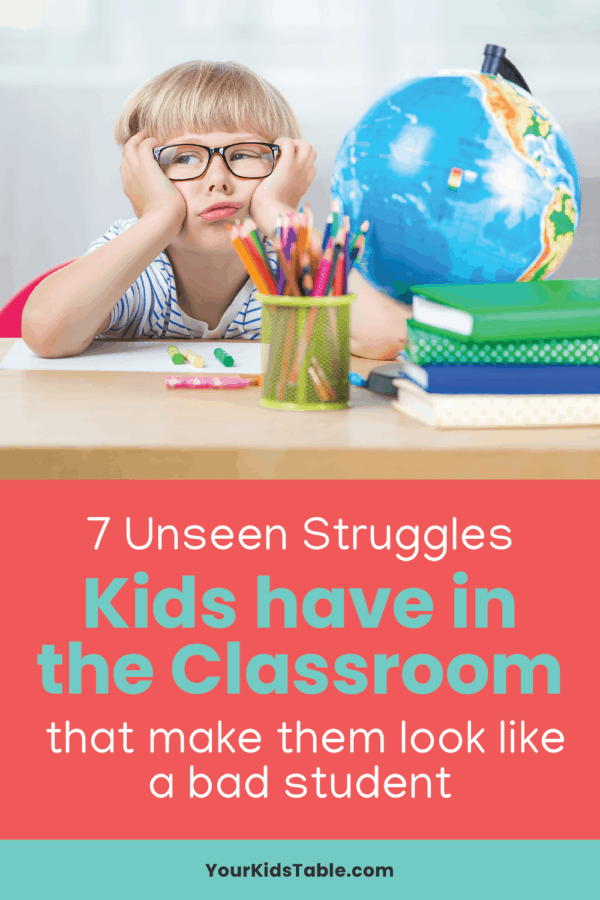Kids can easily fly under the radar with all sorts of hidden struggles they face in the classroom. Learn 7 often unseen ways your child might struggle in the classroom and how you can help them work through it!
Does your kid seem uninterested in school?
Or, maybe they dread it?
Do you get bad reports on their behavior and school work from the teacher on the daily?
Or, maybe since online learning you’ve noticed that your child doesn’t quite seem to keep up with the other kids, they need a lot of help from you, more than they should?
There could be a very good reason, actually lots of reasons, that your child may struggle or not give any care at all about school.
Sure, some reasons are obvious, for example, if your child has anxiety or has a known learning disability, but so many kids have other hidden struggles that keeps them flying under the radar, yet struggling in the classroom every single day.
7 Unseen Struggles Kids Might Have in the Classroom
When you know the reason your kid is having a hard time following along in class or writing their spelling words, it empowers you to be able to help them. That’s why I want to shine a light on these often unseen struggles. Each of them can absolutely be improved, if not totally overcome!
Struggle #1: Avoiding reading, lots of mistakes on worksheets
While there are lots of reasons kids may struggle to read, there’s one in particular that I want to focus on here, visual discrimination. Visual discrimination is our ability to tell things apart just by looking at them. For example, when you look in your closet jammed with all sorts of clothing, your able to discriminate the difference between your purple sweater and purple cardigan.
We take this skill for granted, but some kids may struggle with it.
Signs of Visual Discrimination Difficulties:
At home, your child may not notice small, but noticeable changes in objects. If you say, get the smallest banana, they may just see a bunch of bananas and can’t sort out which is the smallest.
At school, your child may struggle to tell the difference between b, p, d, and q. If those letters are constantly being confused in their head, they can’t read them, which leads to them feeling very frustrated.
Improving Visual Discrimination:
To help your child improve their visual discrimination, it’s important to figure out how much they’re able to visually discriminate. You can find some simple free worksheets here and do some along side your child, along with visual sensory activities. See how much help they need. If they’re able to work through them, this could strengthen their visual discrimination skills.
If these tasks seems too challenging, make them easier by creating your own simpler worksheets or by playing games in your own home with different objects or flash cards. Lay out flash cards or even easier, some matching items, like a variety of blocks. Take turns calling out a shape and color of a block and seeing how fast they can find it.
To get more help, get an evaluation by an OT or a developmental visual therapist.

Struggle #2: Slouching on desk, putting their head down
This struggle can fly way under the radar. Some kids can’t seem to sit up straight, they lounge all over the place and often slump forward on their desk and may even put their head down. While this can also be a sign of low registration (see struggle #6). It’s also a huge sign for weak core muscles.
Therapists often call this poor core strength.
Being slumped over in class might not seem like it’s that big of a deal, but if your child finds it too cumbersome to sit upright, it’s harder to follow what is being taught in front of them. They’re more likely to miss important concepts and may not want to participate in activities that are too taxing (gym and recess).
You may be surprised to learn that poor core strength also affects handwriting!
If the stomach and chest muscles aren’t strong, they can’t support the shoulder. And, the shoulder can’t support the wrist, and the wrist can’t support the fingers.
It’s a big trickle down effect!
Improving Core Strength:
Core strength can be improved through good old exercising like sit ups and planking. But, some kids, especially young ones, won’t be motivated to participate in those. In that case, you can try fun games like crab walking, sitting on a scooter board, and using just their feet to push themselves, and wheelbarrow walking.
You can find more core strength activities from The Inspired Treehouse here.
Struggle #3: Difficulty following directions
Some kids can’t seem to follow directions, and they often get labeled as bad. Of course, not following directions can be a choice a child makes, but you often know it’s behavioral if your child turns and looks at you as you tell them not to throw the toy.
If your child seems to not hear directions or has trouble following multi-steps, something more might be going on. For instance, if you tell your child, “Put away your bookbag, put your shoes away, and turn off the lights in the hallway,” they might only do one. Or, none.
If they often get distracted, this could play out in a school setting too…
They may forget to complete work, bring assignments home they should’ve completed in school, or you get reports from the teacher telling you they’re having a hard time following directions!
This could happen because of sensory processing difficulties. Specifically, that they’re focused on trying to get more movement (aka sensory seekers) and/or they have trouble with auditory processing.
Auditory processing is all about taking the sounds in from the environment and making sense of them. That includes verbal directions from a teacher. So, if the teacher says, “Get out your math book, flip to page 52, and work through problem 8,” they have to be able to process, retain, and then act on each of those steps.
Kids will often get flustered or embarrassed that they can’t remember all the steps. They might not ask for help and just get busy with something else. When the teacher sees they aren’t even on the right page, they get in trouble.
Helping Your Child with Auditory Processing Difficulties:
You can also teach your child to write down instructions, or ask the teacher to provide visuals if you suspect this is the cause of the their difficulty following directions. If they still need more help, reach out to the school’s speech and language therapist.

Struggle #4: Can’t sit still, gets up 100 times!
The child that wants to move so much they get distracted and don’t follow directions is another common struggle in the classroom. These kids can also be very antsy, and have a hard time sitting still.
They’ll often ask to get up a hundred different times in one class, and will fidget all over the place. Their brain is so focused on running, jumping, and climbing that it can think of nothing else, including learning or following any directions!!!
Teachers may think the wiggly/active child is being bad, or purposefully disruptive, that’s why it’s so important to be aware that there’s a reason for all the disruption.
Improving the Wiggles:
If you have a child with a lot of energy, then they’d likely benefit from some sensory activities before school or even in school. (These sensory diet activities are a great place to start.)
Sensory activities that get them moving like jumping on a trampoline, riding their bike to the bus stop, or doing a movement break in between lessons.
Struggle #5: Overly quiet, doesn’t want to be at school, cries
Some kids are at the opposite end of the activity spectrum and they’re super still and quiet. And, some of those kids aren’t just quiet, they feel scared of school, they may cry when they’re there and seem too shy to participate.
While anxiety can for sure play a role in this type of behavior, it’s often overlooked that a child might be experiencing sensory overwhelm. Sensory overwhelm is when any of the sensations in the environment are too much. Your child might get agitated too by the buzzing of the lights, the kid two desks over tapping their pencil, or the smell of hotdogs wafting from the cafeteria.
Kids don’t always know how to voice these concerns and so they turn inward to protect themselves. They may even avoid socializing with peers because other kids are too loud or might bump into them.
The teacher sees a child that’s sensitive and shy, but when a child is bothered to that point by all those sensations, then it’s far more than personality. It’s also their sensory processing.
Signs your child is sensitive to sensations:
- Covers ears in public restrooms with hand dryers
- Hates the noise from blow dryers or vacuums
- Covers eyes because lights are too bright
- Complains of frequent headache from lights
- Scared of people bumping into them
- Refuses to ride swings or play on playground equipment
- Dislikes rough house play
- Complains often of smells
- Dislikes hands getting messy
- Won’t walk barefoot in grass or sand
Improving Sensitivities:
Knowing that your child has these sensitivities is half the battle, so many sensitivities get dismissed as over-dramatic or personality preferences.
To help your child, come up with solutions to avoid or minimize the sensations that irritate or are painful. For instance, if the cafeteria smell is really strong, they can keep a roll on of an essential oil they do like and swipe it across their wrist.
You can also talk to the teacher and get permission for them to wear a hat or maybe teach with the lights off on bright days. Some sensitivities, like sensitivity to textures and movement, can slowly learned to be tolerated if you start in small doses.
Your child may refuse to finger paint, but maybe they can start with a paintbrush and over time, work their way up to touching the paint with their finger tip.
After school, these kids usually need some time to decompress because they’ve been fighting overwhelm all day!
Struggle #6: Zoned out all the time, can’t focus
Maybe your child struggles to focus across the board, they’re often zoned-out. While some kids are day dreamers, it could be sensory low registration if you notice they prefer to lay around, even though they’ve had plenty of sleep. Or, that they never really want to do anything. The rest of the family might be a playing a game, but they just want to stay on the couch.
Low registration is basically when a child’s brain doesn’t seem to notice sensations in their environment, it’s as if they’re under stimulated, although that’s not the case.
The brain just isn’t processing the sensations well and you see these kinds of behaviors as a result.
Improving Low Registration:
If your child has low registration, they might seem lazy, but fast and bold sensory activities can help get them to zone in, focus. Think about trying jumping jacks as fast as they can go. Chewing on ice or bouncing on a large ball. Using these activities before school, at certain intervals, or as needed to make a big impact on their ability to attend and focus.

Struggle #7: Poor handwriting
So many kids struggle with poor handwriting for a multitude of reasons, perhaps the most common is fine motor skills. But, visual perceptual skills can also be a factor, as well as several of the struggles we already talked about including:
- low registration
- poor core strength
- seeking movement/sensory input
Did you notice signs for any above in the other 6 struggles? If so, it also may be affecting their handwriting. For instance, kids with poor core strength may not have the developed the fine motor skills, but working on core strength will lay the foundation for those fine motor skills needed for handwriting.
Or, if your child has low registration, then they might need a weighted pencil to use the needed pressure to write.
Lastly, kids that seek movement/sensory input may be too distracted to pay attention to handwriting, giving them sensory activities to meet their needs before handwriting activities can improve their skills!
The “Thing” All 7 Struggles Have in Common…
Every one of these struggles above has a common thread: sensory processing. Whether you’ve heard of sensory “issues” or not before in kids, they are vast and can affect kids in all sorts of particular ways. To learn more about how to help them with some of my favorite (easy) sensory activities, download our free printable:
Click here to download: 25 Powerful Sensory Activities to Calm and Focus Your Child
Get some ideas right in your inbox!
More Help for Kids Learning in School
13 Easy Sensory Strategies for the Classroom
Easy Movement Break Ideas Kids Can Do at Home or School
Easy Ways to Help Your Kid Focus on Homework
How to Keep Kids Focused for Online School
Alisha Grogan is a licensed occupational therapist and founder of Your Kid’s Table. She has over 15 years experience with expertise in sensory processing and feeding development in babies, toddlers, and children. Alisha also has 3 boys of her own at home. Learn more about her here.
